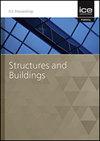Effect of bridge design parameters on multihazard performance of river crossing bridges
IF 1.4
4区 工程技术
Q3 CONSTRUCTION & BUILDING TECHNOLOGY
Proceedings of the Institution of Civil Engineers-Structures and Buildings
Pub Date : 2023-04-05
DOI:10.1680/jstbu.22.00168
引用次数: 0
Abstract
River crossing bridges in seismically active regions are typically susceptible to two natural hazards – earthquakes and floods. For such bridges, design parameters related to piers may play major roles on bridge multihazard performance. The current study explores the same for key bridge design parameters – aspect ratio and longitudinal reinforcement ratio for piers, and differential ground elevation between multiple bents. Multihazard condition at the southeast part of Nepal is considered as hazard condition at testbed. Regional seismic hazard is represented with a suite of earthquakes generated based on regional seismic design spectra. Due to the regional flood hazard, expected pier scour of investigated bridges are estimated from 100-year flood discharge (including climate change projection) in the Koshi river, Nepal. Three-dimensional finite element models of chosen bridges, without and with scour, are developed including ±10% variations in the stated design parameters. Fragility and risk curves of the investigated bridges are developed and compared to assess relative influences of the design parameters on performance of these bridges. Observations signify that pier aspect ratio and longitudinal reinforcement ratio can significantly influence the multihazard performance of riverine bridges. Research outcome also demonstrates how design parameters may be revised to perform risk-targeted multihazard design of bridges.桥梁设计参数对跨河桥梁多灾害性能的影响
地震活跃地区的跨河桥梁通常容易受到地震和洪水这两种自然灾害的影响。对于此类桥梁,与桥墩相关的设计参数可能对桥梁的多灾害性能起主要作用。本研究对关键桥梁设计参数-桥墩的纵横比和纵向配筋比以及多个弯道之间的地面标高差进行了同样的研究。将尼泊尔东南部的多灾害条件视为试验台的危险条件。区域地震危险性用一组基于区域地震设计谱产生的地震来表示。考虑到区域洪水灾害,根据尼泊尔Koshi河100年洪流量(包括气候变化预测)估算了被调查桥梁的预期桥墩冲刷。所选桥梁的三维有限元模型,无冲刷和有冲刷,包括±10%的变化,在规定的设计参数。建立并比较了所研究桥梁的易损性和风险曲线,以评估设计参数对这些桥梁性能的相对影响。结果表明,桥墩宽高比和纵向配筋率对河流桥梁的多灾害性能有显著影响。研究结果还证明了如何修改设计参数来进行以风险为目标的桥梁多灾害设计。
本文章由计算机程序翻译,如有差异,请以英文原文为准。
求助全文
约1分钟内获得全文
求助全文
来源期刊
CiteScore
3.40
自引率
6.20%
发文量
61
审稿时长
12 months
期刊介绍:
Structures and Buildings publishes peer-reviewed papers on the design and construction of civil engineering structures and the applied research associated with such activities. Topics include the design, strength, durability and behaviour of structural components and systems.
Topics covered: energy conservation, people movement within and around buildings, strength and durability of steel and concrete structural components, and the behaviour of building and bridge components and systems

 求助内容:
求助内容: 应助结果提醒方式:
应助结果提醒方式:


